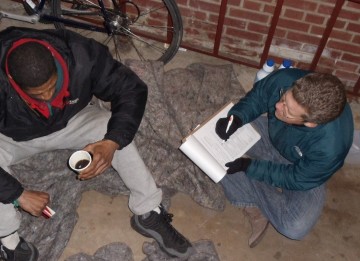Once a year, Washington, DC is among the more than 3,000 cities and counties which participate in the national Point-In-Time Homeless survey coordinated by HUD. Last Thursday more than 180 bundled-up volunteers canvassed buildings, bridges, and back alleyways looking for the homeless neighbors in our community, many of whom have no choice but to seek shelter in our public spaces.
Capitol Hill Group Ministry (CHGM) was once again proud to lead two of the city’s volunteer teams through the Capitol Hill community and to be joined by HUD Secretary Donovan, VA Secretary Shinseki, and numerous key members of their agencies’ staffs. CHGM staff and volunteers were delighted at the opportunity to work closely alongside our federal partners in serving the homeless.
The Point-In-Time censuses are organized locally, with all the counts being conducted during the last 10 days of January. The numbers collected, while imperfect and lacking the ability to count individuals and families “doubled-up” on couches and floors in temporary homes, provide a baseline of the homeless population across the US.
The numbers help private and government agencies identify gaps in services and to better allocate dwindling funding. The January 2012 count found 633,782 homeless persons nationally, with 6,954 coming from the District.
“I tell my staff, you can’t sit in Washington with a thousand-mile-long screwdriver and try to fine-tune everything,” Shinseki said. “I’m at the other end of the screwdriver now. This is where problems get solved.”
True to his word both Shinseki and Donovan and their staffs were active participants in conducting surveys, identify resources, and in offering general comfort and compassion to the individuals surveyed late into the evening. It was apparent that with the temperature hovering around the lower thirties both parties were truly passionate about the accuracy of the count and effectiveness of homeless services. Their participation was no media charade or simple photo op.
It is essential to the success of homeless services that we know how we are doing and that we remind those still homeless that we care. CHGM’s Street Outreach Program does just that by building relationships with individuals often looked past.
Individuals living on the street are prone to give up on themselves and the services still available to them. Many struggle with mental illness and substance abuse, often both. As a result, national statistics indicate that the average lifespan of the street homeless is only 47 years old.
CHGM would like to offer a sincere thank you to all of the volunteers who assisted in this year’s count, to the city organizers for all of their hard work, and to the USICH, VA, and HUD staff for helping CHGM “Serve the Community, One Neighbor at a Time.”



